- Author Arianna Cook [email protected].
- Public 2024-01-12 17:55.
- Last modified 2025-01-23 09:40.
Why do my legs swell and how to deal with it? Compresses and baths, gymnastics and massage, pharmacy gels and ointments. Does it make sense to drink diuretic drinks?
Swelling of the legs is the accumulation of fluid in the intercellular space of the muscle tissue of the lower extremities. When, due to one reason or another, it occurs, the feet and legs begin to swell, increasing in size, which not only looks unaesthetic and gives unpleasant sensations, but also threatens much more serious health problems in the future. That is why, and not at all because of momentary inconvenience, you should as soon as possible find out why the swelling in your legs haunts you, and find a reliable way to eliminate them.
What is leg edema?
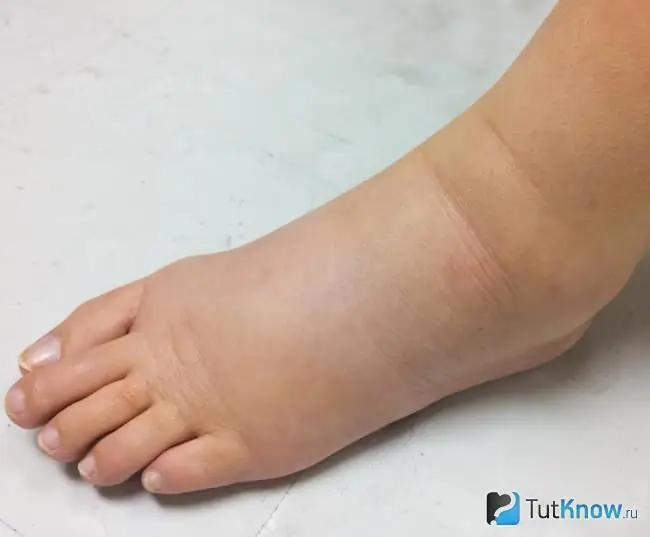
In the photo, swelling of the leg
The legs are the lowest part of the body, which is upright for most of the day and is subject to maximum stress. This leads to an imbalance between the fluids in the vessels and in the intercellular space of the body in favor of the latter. As a result, the muscle tissue "swells", the feet and legs swell, bruises and spider veins appear on the skin, and the person feels fatigue, pain and burning sensation in the lower extremities.
Edema is:
- Local … They appear on one leg or concentrate in a specific area - for example, only on the ankles or the top of the foot.
- Pastose … They are characterized by slight swelling of the tissues of the lower part of the lower leg and almost never rise higher. They can be identified by the traces of the socks that have been imprinted on the skin, unless, of course, in the morning you mistakenly chose a couple of sizes smaller socks.
- Expressed … These are severe swelling of the legs, which cover the entire space of the lower extremities from the foot to the knee joint, and in peak cases rise to the thigh. They can be seen with the naked eye.
If edema occurs from time to time, it is a natural reaction of the body to certain external events: you overworked in the gym, put on uncomfortable shoes, and carried a heavy backpack on your back all day. In this case, nothing special is required, except to try not to repeat the mistakes made.
If your legs are swelling day after day, regardless of the circumstances, or their swelling gets stronger over time, there is a great chance that we are talking about pathology, and you need to undergo a medical examination.
Note! If the legs are very swollen, over time, the skin that cannot withstand constant stretching can become covered with cracks, ulcers and erosions, from which fluid begins to ooze. In addition, impaired blood flow in the pinched veins provokes thrombosis and thrombophlebitis. That is why it is unacceptable to be frivolous about edema.
Causes of leg edema
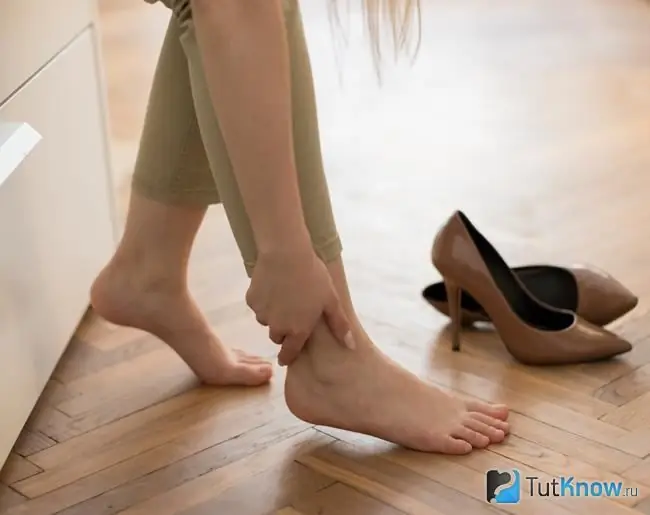
Fortunately, in most cases, the causes of leg edema are very commonplace and do not indicate disturbances in the functioning of the body. They can be easily calculated by simply remembering the past day.
Relatively harmless reasons why legs swell:
- A profession associated with the need to spend a long time on your feet (hairdresser, teacher, courier) or in a static position (truck driver, pilot of long-distance flights);
- Significant excess weight, especially gained as a result of pregnancy, when the volume of fluid in the body increases, and hormonal shocks disrupt the natural course of physiological processes;
- In addition to pregnancy, the natural cause of leg edema in women may be the approaching menstruation, due to which fluid retention occurs, a gain of 2-3 extra pounds and the appearance of edema;
- Overloading in the gym;
- Carrying heavy weights;
- Uncomfortable, tight, high-heeled shoes;
- Drinking too much liquid
- The habit of sitting with crossed ankles, with the leg crossed over the leg, etc.;
- The increased ambient temperature, due to which the veins expand and can no longer fully "push" the blood up the body, and the body loses salts that help to draw fluid from the tissues - this is why the legs swell more in the heat.
Note! The reasons listed above are harmless, since the edema caused by them is in no way associated with the disease and, as a rule, go away on its own. But that doesn't mean they can be ignored!
Pathological reasons why the legs swell:
- Disorders of the cardiovascular or urinary system;
- Liver disease;
- Diseases of the joints;
- Varicose veins;
- Diabetes;
- Hypothyroidism or other thyroid problems;
- Injuries.
It is impossible to treat on your own the edema caused by disruptions in the activity of the body, if only because in this case, fluid retention is only a symptom of a more formidable disease. But it is possible to remove leg edema at home, which is a consequence of external circumstances, and measures for this will require relatively simple measures.
What to do if your legs are swollen?
The most common advice, which must have been received by every person whose legs are swollen in the evening, sounds like this: take off your shoes, take off your socks, lie down with your feet above the level of your heart, and lie down for 20-30 minutes. The recipe is effective, it works well, but you won't go far on it alone. To get a decent result, actively use the recipes of the people's first-aid kit and the achievements of modern science - they will help you more accurately.
Baths for leg edema
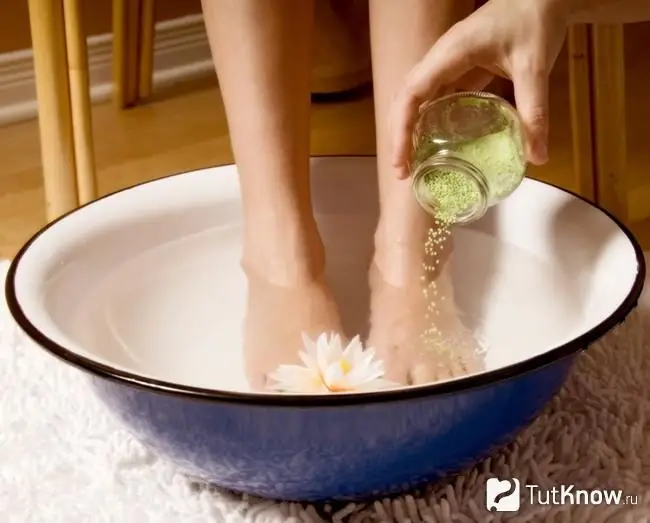
This is one of the easiest and most enjoyable home remedies for leg swelling. Lowering your swollen feet into lukewarm water, flavored with healing solutions, you will almost immediately feel relief: fatigue will go away, heaviness will decrease, and after a while the swelling will subside.
How to prepare a bath:
- With herbs … Take 100 g of any herbs shown for swelling of the legs - birch leaf, elderberry, St. John's wort, calendula, burdock root, nettle, linden, coltsfoot, mint, ivy, chamomile or sage. Pour 3 liters of boiling water, let it brew until the broth cools down to a temperature pleasant for the skin, strain, pour into a basin and lower your feet into it for 15-20 minutes.
- With needles … Use 100 g of spruce, fir or pine needles for brewing. It's great if you can add a handful of juniper berries to them.
- With salt … Dissolve 100 g of sea salt in 3 liters of warm water and immerse your feet in it. After finishing the procedure, rinse your skin with clean water to rinse off the salt.
- With essential oils … You can enhance the effect of any bath by adding 10-12 drops of essential oil of geranium, grapefruit, oregano, ginger, lavender, juniper, nutmeg, patchouli, chamomile, fennel, tea tree and eucalyptus to the water.
- With menthol … An equally effective remedy for swelling of the toes and feet is a bath with cooling and soothing menthol, which can be found either in ready-made bath mixes or in specialized stores for making home cosmetics.
After completing the procedure, the legs should be thoroughly dried with a towel, lubricated with moisturizer and put on socks.
An interesting method that allows you to quickly get rid of strong, pestering legs even during the day, are contrasting baths. Their meaning is that, alternately placing the feet in a basin with either warm or cold water for 30 seconds, accelerate the outflow of fluid from the tissues. In this case, salt can be added to warm water, and herbal infusion and menthol can be added to cold water. The only thing is, be careful not to overexpose your feet in cold water and not get cystitis.
Note! To facilitate the bathing process, you can replace it with a contrast shower.
Compresses against leg edema
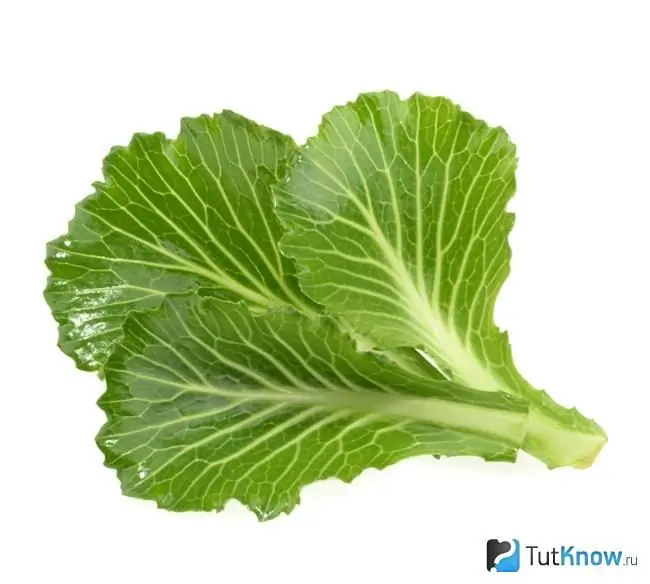
If the edema is accompanied by pulling pain and does not want to subside for a long time, a more effective remedy is required, which can be a compress securely fixed on the affected area of the body with a bandage. Keep it for 2-3 hours or overnight.
The most popular decongestant compresses are:
- Cabbage … Place the cabbage leaves crushed with a rolling pin to the back of the leg. You can also use young burdock leaves.
- Parsley, lettuce, horse sorrel … Chop the leaves with a knife and place them on the cheesecloth to be secured to the leg.
- Herbal decoctions … Instead of preparing the infusion for the bath, 2-3 tbsp. l. any of the herbs listed above is poured with a glass of boiling water, allowed to cool, filtered and moistened in a broth with a bandage, which is then wound around the feet, ankles or ankles of the legs from edema. For greater benefit, you can dissolve 1 tbsp in the broth. l. sea salt or honey.
- Linseed oil … They liberally lubricate the leg with it, wrap it with cotton cloth, and then with polyethylene. You can also use olive and camphor oils.
- Potato … Mashed potatoes, cooked from well washed, but unpeeled and crushed together with the skin of the tubers, are used warm and kept under the bandage for no more than 30 minutes.
- Alcoholic infusion of Kalanchoe leaves … Grind the raw materials and soak in regular vodka for 14 days. In the infusion, the tissue is moistened and applied to the swollen areas of the legs. Keep the compress for about 1 hour.
Surely you know how to relieve leg swelling resulting from an injury - apply ice to it or, like the heroes of American films, a package of frozen vegetables from the freezer. This method also works with other types of edema, just remember to wrap the cooling compress in a napkin to protect your skin from cold burns, and do not keep ice on your body for more than 15 minutes.
Diuretic drinks for leg swelling

Medicines that promote the elimination of fluid from the body are taken strictly according to the doctor's prescription. If you decide to neglect this rule, you run the risk of getting rid of potassium along with excess water, provoke salt deposition, increase your chances of acquiring diabetes, and become closely acquainted with insomnia, weakness and seizures.
Herbal diuretics are milder and therefore considered safer. But they shouldn't be abused either. If their use does not bring results within 1 month, you still have to visit a doctor.
If your legs are very swollen, the following will come to the rescue:
- Green and black tea with milk … Brew and drink them 2-3 times a day as usual.
- Herbal collection … Prepared on the basis of St. John's wort, corn stigmas, mint, horsetail, caraway seeds, rose hips, knotweed herb, elderberry flowers and berries, lingonberry leaf or ready-made pharmaceutical preparations. 6 tsp raw materials from the selected plant, pour 600 ml of hot water and hold for 10 minutes in a steam bath or 2 hours in a thermos. Cool, strain and take 1 glass 2-3 times a day.
- Parsley root decoction … 1 tbsp. l. Pour the dried and chopped root with 2 cups of cold water, bring to a boil and cook over low heat for 5-7 minutes. Strain the cooled drink and drink in 3 doses throughout the day. This should be done before meals.
- Bean leaf decoction … 1 tbsp. l. dry leaves are brought to a boil in 0.5 cups of water, removed from heat and insisted for about 1 hour. The finished drink is filtered and taken during the day in 2-3 stages.
- Freshly squeezed juice cocktail … For its preparation, use cucumber, carrots and lemon. Juices are mixed in equal volumes and diluted with clean drinking water in a 1: 1 ratio. It is consumed daily for 1 glass.
Also, watermelon and pumpkin will cope with a similar task. The first fruit is famous for its diuretic effect, so it is simply eaten in any quantity. The second one acts less pronounced, but at the same time it works “for the future” and gradually restores water exchange and body metabolism. Pumpkin is used in any form: squeeze juice, stew, boil with porridge, etc.etc.
Note! Herbal teas can cause itching, hives, or swelling. If you know you have a tendency to allergic reactions, refuse to use unfamiliar infusions. If you don't know, use them with caution anyway.
External remedies for leg edema
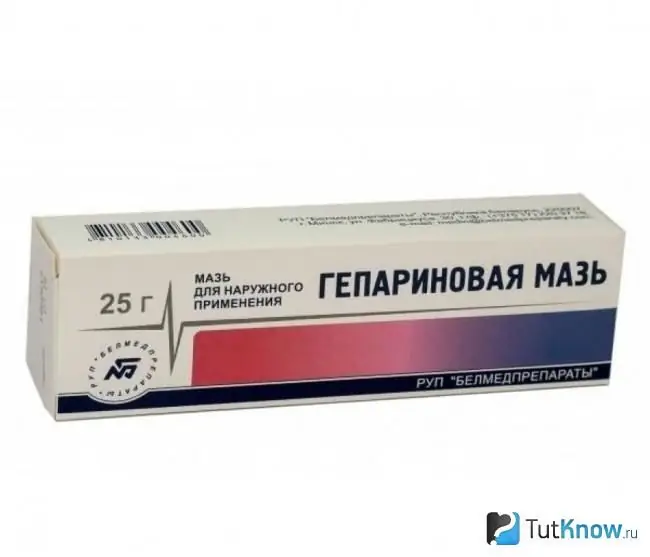
In the photo Heparin ointment from edema of the legs at a price of 50 rubles.
Phlebotonic ointments stimulate blood circulation, increase the tone of blood vessels, and accelerate the processes of fluid removal from tissues. However, each of these remedies has its own list of contraindications, so a doctor's consultation is necessary before using them. A professional will not only choose the most suitable remedy for you, but will also explain in detail how to deal with the reasons due to which the legs swell, what to do to minimize their effect, how to prevent swelling, how to prevent it from developing into a more serious disease.
Phlebotonics include:
- Heparin ointment … It has an anti-inflammatory effect, normalizes the balance of fluids in the body, and activates blood flow. Manufactured in Russia. Costs from 50 rubles. for 25 ml.
- Sophia … A separate line of vascular care creams from the Russian "Korolev Pharm". Includes 3 types of cream - with leech extract, urea, menthol. It takes care of veins, relieves pain and spasms, helps with swelling. It costs 130-230 rubles. for 200 ml.
- Troxevasin … The tool is designed to strengthen the walls of blood vessels, but partly promotes the elimination of fluid. Produced in Bulgaria. Costs from 200 rubles. for 40 ml.
- Detralex … The gel is used to treat minor bruises and sprains, remove bruises, relieve varicose veins and prevent the appearance of edema. Produced by a French company. It costs about 500 rubles. for 40 ml.
- Lyoton … The gel stimulates blood circulation, helps to remove excess fluid, although it often causes dry skin. Country of origin - Italy. It costs 500-600 rubles. for 50 ml.
If at the moment, for some reason, you cannot get a consultation with a specialist, this is not a reason to buy a pharmaceutical product without a prescription. For a person without medical education, who is not able to say with confidence what to do with edema of the legs, a worthy solution would be to buy a cosmetic product with an anti-edema effect, which not only does not harm, but also moisturizes the skin and even helps to cope with cellulite.
Anti-edema cosmetic gels:
- Easy Step toning gel with essential oil of mint from Aravia (Russia) … In addition to peppermint oil, it boasts vitamin P and horse chestnut extract. Relieves fatigue, refreshes, tones, removes congestion in tissues, restores blood circulation. It costs 540 rubles. for 550 ml.
- Duo foot gel from Guam (Italy) … Improves metabolic processes and blood microcirculation, relieves swelling, fatigue, heaviness in the legs. It has a lymphatic drainage effect. Contains a complex of oils and plant extracts. It costs 1,500 rubles. for 75 ml.
- Feather-Light Legs foot gel from Thalgo (France) … Tones the veins, copes with the feeling of heaviness, reduces swelling. Includes a complex of herbal extracts. It costs 2300 rubles. for 150 ml.
If necessary, it is allowed to use other anti-cellulite gels, since they all have a lymphatic drainage effect and, therefore, the ability to relieve light edema on the legs - ankles, calves and even feet can become a natural area of their application, despite the absence of traces of cellulite. But cosmetic products will not be able to cope with serious edema; more qualified help is needed here.
Gymnastics against leg swelling

Surprisingly, primitive exercises, feasible even for kindergarten children, become a powerful tool in the fight against edema. They should be performed regularly, 1-2 times a day.
Exercises for edema:
- Roll from heel to toe.
- Walk on the inside and outside of your foot.
- Sitting on a chair, raise your legs straight at the knees in front of you and rotate your feet.
- Lying on your back, do the "bike" exercise.
- Pick up small objects from the floor - pencils, key chains, buttons - with your toes.
The number of repetitions is determined based on your physical fitness. You should not strain yourself during gymnastics, but you should not limit yourself to 1 set of 10-12 repetitions either.
Massage against leg swelling
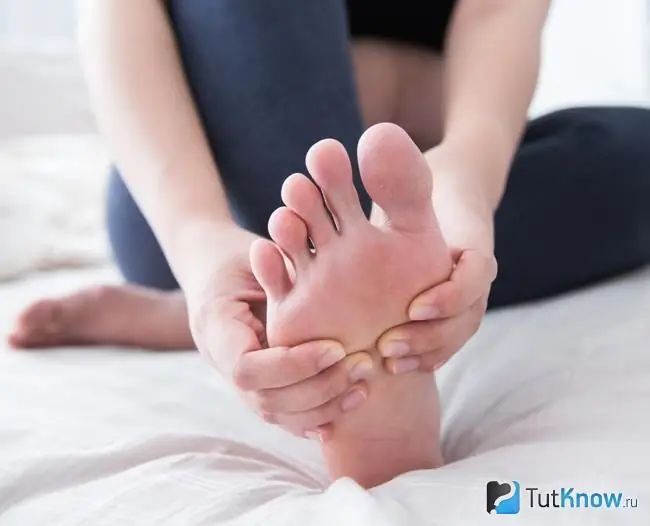
Soft, gentle rubbing has a good effect on the flow of lymph and blood, strengthens the walls of blood vessels, cope with congestion in the tissues. This is exactly the procedure that you should think about as soon as you first discover that your legs are swollen in the calves or on the feet (it is better to entrust the massage of the ankle with the joints located on it to a professional).
For 10 minutes, slowly and gently rub the affected area, previously lubricated with lymphatic drainage cream or vegetable oil, with your fingertips, then dab your feet with a paper towel and go to bed. It is very good to do a contrast shower or bath before the procedure.
Note! All of these methods are designed for a healthy person without any changes in physical condition. Getting rid of swelling of the legs during pregnancy or, for example, varicose veins, goes according to a different scheme. Check it with your supervising doctor, who will help you choose safe folk methods and pharmaceuticals in your case.
Prevention of leg edema
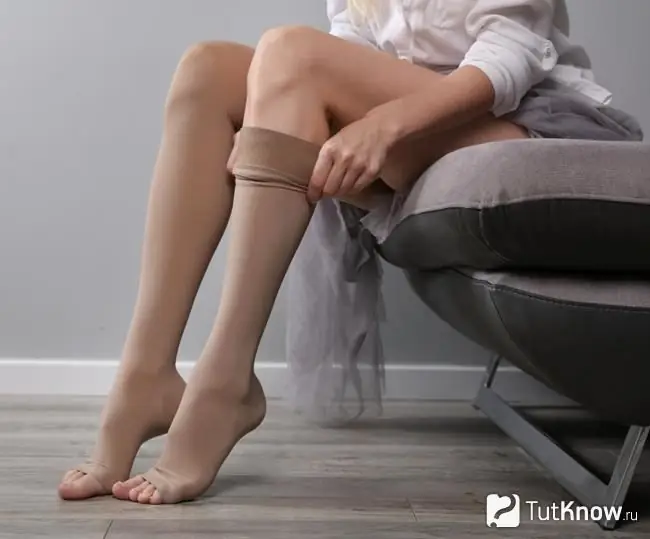
A successful fight against fluid retention in the tissues of the body should begin with the elimination of the factors provoking it. If you don't want baths, compresses, diuretic teas and other remedies for leg edema to become your constant companions, reconsider your lifestyle.
First things to do:
- Keep weight under control.
- Change your shoes. It should be fit, comfortable and made of breathable materials. And give up heels that are more than 4 cm high.
- Limit salt and carbohydrate intake by replacing them with proteins and foods with a high potassium content - bananas, nuts, dried fruits.
- Drink plenty of water, but be guided by the needs of your body. The 2 liters recommended by nutritionists are not shown to everyone.
- Take a taxi when you are loaded with shopping in the supermarket so as not to carry heavy things.
- If you spend a lot of time on your feet, try to rest your stressed feet during the day - take a minute to sit down and raise them on a bench, do short massages and gymnastics. If you lead a sedentary lifestyle, try to move your legs more often, take short breaks during work to get up from the table and walk around the room, move around the city by bike, not by car.
- Wear compression stockings and tights.
- Sleep with your feet on the pillow.
How to get rid of leg swelling - watch the video:






